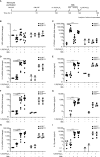Reduced vitamin D-induced cathelicidin production and killing of Mycobacterium tuberculosis in macrophages from a patient with a non-functional vitamin D receptor: A case report
- PMID: 36405761
- PMCID: PMC9672840
- DOI: 10.3389/fimmu.2022.1038960
Reduced vitamin D-induced cathelicidin production and killing of Mycobacterium tuberculosis in macrophages from a patient with a non-functional vitamin D receptor: A case report
Abstract
Tuberculosis (TB) presents a serious health problem with approximately a quarter of the world's population infected with Mycobacterium tuberculosis (M. tuberculosis) in an asymptomatic latent state of which 5-10% develops active TB at some point in their lives. The antimicrobial protein cathelicidin has broad antimicrobial activity towards viruses and bacteria including M. tuberculosis. Vitamin D increases the expression of cathelicidin in many cell types including macrophages, and it has been suggested that the vitamin D-mediated antimicrobial activity against M. tuberculosis is dependent on the induction of cathelicidin. However, unraveling the immunoregulatory effects of vitamin D in humans is hampered by the lack of suitable experimental models. We have previously described a family in which members suffer from hereditary vitamin D-resistant rickets (HVDRR). The family carry a mutation in the DNA-binding domain of the vitamin D receptor (VDR). This mutation leads to a non-functional VDR, meaning that vitamin D cannot exert its effect in family members homozygous for the mutation. Studies of HVDRR patients open unique possibilities to gain insight in the immunoregulatory roles of vitamin D in humans. Here we describe the impaired ability of macrophages to produce cathelicidin in a HVDRR patient, who in her adolescence suffered from extrapulmonary TB. The present case is a rare experiment of nature, which illustrates the importance of vitamin D in the pathophysiology of combating M. tuberculosis.
Keywords: cathelicidin; hereditary vitamin D-resistant rickets (HVDRR); macrophage; tuberculosis; vitamin D.
Copyright © 2022 Al-Jaberi, Crone, Lindenstrøm, Arildsen, Lindeløv, Aagaard, Gravesen, Mortensen, Andersen, Olgaard, Hjaltelin, Brunak, Bonefeld, Kongsbak-Wismann and Geisler.
Conflict of interest statement
The authors declare that the research was conducted in the absence of any commercial or financial relationships that could be construed as a potential conflict of interest.
Figures



Similar articles
-
Vitamin D, vitamin D receptor, and cathelicidin in the treatment of tuberculosis.Vitam Horm. 2011;86:307-25. doi: 10.1016/B978-0-12-386960-9.00013-7. Vitam Horm. 2011. PMID: 21419277 Review.
-
The role of vitamin D receptor in innate and adaptive immunity: a study in hereditary vitamin D-resistant rickets patients.J Clin Endocrinol Metab. 2013 Apr;98(4):1685-93. doi: 10.1210/jc.2012-3858. Epub 2013 Mar 12. J Clin Endocrinol Metab. 2013. PMID: 23482605
-
Increased vitamin D receptor expression from macrophages after stimulation with M. tuberculosis among persons who have recovered from extrapulmonary tuberculosis.BMC Infect Dis. 2019 Apr 30;19(1):366. doi: 10.1186/s12879-019-3958-7. BMC Infect Dis. 2019. PMID: 31039752 Free PMC article.
-
Status of vitamin D and the associated host factors in pulmonary tuberculosis patients and their household contacts: A cross sectional study.J Steroid Biochem Mol Biol. 2019 Oct;193:105419. doi: 10.1016/j.jsbmb.2019.105419. Epub 2019 Jun 27. J Steroid Biochem Mol Biol. 2019. PMID: 31255688
-
Lessons Learned from Hereditary 1,25-Dihydroxyvitamin D-Resistant Rickets Patients on Vitamin D Functions.J Nutr. 2021 Mar 11;151(3):473-481. doi: 10.1093/jn/nxaa380. J Nutr. 2021. PMID: 33438017 Review.
Cited by
-
Vitamin D in Cutaneous T-Cell Lymphoma.Cells. 2024 Mar 13;13(6):503. doi: 10.3390/cells13060503. Cells. 2024. PMID: 38534347 Free PMC article. Review.
-
Nutritional Deficiencies and Management in Tuberculosis: Pharmacotherapeutic and Clinical Implications.Nutrients. 2025 May 30;17(11):1878. doi: 10.3390/nu17111878. Nutrients. 2025. PMID: 40507146 Free PMC article. Review.
-
The association between climate variables and tuberculosis in Kolaka District, Southeast Sulawesi Province, Indonesia, 2013-2020: a Bayesian autoregressive model.F1000Res. 2024 Jun 21;12:1507. doi: 10.12688/f1000research.138859.2. eCollection 2023. F1000Res. 2024. PMID: 39176259 Free PMC article.
-
A Comparison of Cathelicidin Levels in the Skin of Leprosy Patients and Their Household Contacts.Acta Med Acad. 2023 Dec;52(3):195-200. doi: 10.5644/ama2006-124.424. Acta Med Acad. 2023. PMID: 38407086 Free PMC article.
References
-
- WHO . Global tuberculosis report. (2021). Available at: https://www.who.int/publications/i/item/9789240037021
Publication types
MeSH terms
Substances
LinkOut - more resources
Full Text Sources

